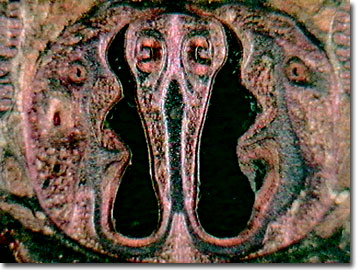Darkfield Digital Image Gallery
Pig Tooth Enamel Formation
As mammalian omnivores, pig teeth are fairly good models for studying the development and aging of human teeth. Dental enamel is formed by the epithelial cells of the enamel organ including the ameloblasts, the cells that produce enamel matrix proteins.

As with humans, pigs feature molars, premolars (or bicuspids), canines, and incisors and similar to most mammals, pigs and humans are diphyodont or develop and erupt two generations of teeth into their jaws. In the pig's deciduous (baby teeth) formula of 3/3, 1/1, 3/3, there are three incisors, one canine, and three premolars on each side of the bottom jaw for a total of 28 teeth as compared to humans with 20 primary teeth growing into a mixed dentition of permanent and primary teeth that ends by age 13 years. For permanent teeth, pigs exhibit a dentition formula of 3/3, 1/1, 4/4, 3/3 or three incisors, one canine, four premolars, and three molars on each side of the top and bottom of the mouth for a total of 44 teeth. Humans, on the other hand, are characterized by a permanent dentition of 32 teeth, 16 upper, 16 lower, and canines that hopefully never approach the tusk-like appearance of a mature boar hog. Baby pigs undergo the painful process of teething just as human babies suffer.
Pig and human teeth are protected by outer coatings of enamel, the hardest tissue in the body. Below the crown line, the root of the tooth is protected by cementum. The bulk of the tooth below the enamel and cementum is the dentin, which lines the pulp cavity. Within the central, innermost portion, the pulp performs the formative, sensory, nutritive, and other functions for the life of the tooth. Using tissue culture techniques in the laboratory, ameloblasts have produced enamel protein matrices using secreted enamelysin, an active proteolytic enzyme, to process and slowly degrade proteins in secretory stage enamel.
Contributing Authors
Cynthia D. Kelly, Thomas J. Fellers and Michael W. Davidson - National High Magnetic Field Laboratory, 1800 East Paul Dirac Dr., The Florida State University, Tallahassee, Florida, 32310.
BACK TO THE DARKFIELD IMAGE GALLERY
BACK TO THE DIGITAL IMAGE GALLERIES
Questions or comments? Send us an email.
© 1995-2025 by Michael W. Davidson and The Florida State University. All Rights Reserved. No images, graphics, software, scripts, or applets may be reproduced or used in any manner without permission from the copyright holders. Use of this website means you agree to all of the Legal Terms and Conditions set forth by the owners.
This website is maintained by our
Graphics & Web Programming Team
in collaboration with Optical Microscopy at the
National High Magnetic Field Laboratory.
Last Modification Friday, Nov 13, 2015 at 01:19 PM
Access Count Since September 17, 2002: 45077
Visit the website of our partner in introductory microscopy education:
|
|
